Shoei GT Air 2 Review
Published on: 19 December 2018
CLICK SHOEI GT-AIR 2 HELMET TO SHOP WITH FREE UK NEXT DAY DELIVERY
The Shoei GT Air helmet has been around since 2013. That was the year we first opened the doors at Motolegends. We only started selling Shoei helmets a couple of years ago, so it’s a helmet we have never offered to our customers.
The GT Air is very much a helmet that is aimed at the touring and commuting market. In 2023 Shoei launched the newest version of this, the Shoei GT Air 3 helmet.
It’s not designed for sports bikes. And it wouldn’t look right on a retro or classic bike. It’s a helmet that you’d only really wear on a more modern sit-up bike. It would also work perfectly well on an adventure bike, although it doesn’t come with a peak or the ability to exchange the visor for goggles.
But for 90% of those who want to ride with a full-face rather than a flip-lid, the GT Air would probably be the perfect helmet. It covers all the bases, and performs well in all areas. It’s light, is comfortable, well-vented and quiet. It is also equipped with a drop-down sun visor.
There are lots of helmets out there, hundreds probably, that purport to do what the GT Air does, but none does it to the level that Shoei does.
In fact, we have come to the view that when you take into account all the factors that make a helmet work, no other manufacturer can hold a candle to Shoei. The Japanese maker takes the science of helmet making to another level.
Over the years, we have dealt with all the best known and most prestigious helmet brands on the market: Arai, Bell, Schuberth, HJC, Nolan, AGV, Shark, Nexx, and so on. In truth, in terms of the quality of construction, reliability, comfort and safety, no other manufacturer comes close.
Of course, if you want wacky graphics, race-track aerodynamics, featherweight lightness and aggressive looks, Shoei might not be the brand for you. But if you value the attributes that are less about making you look great, and more about making your ride great, then for us it’s Shoei all day long.
But the GT Air has been around for six years. It’s still a very good helmet that we know many of our customers rate highly, but it was due for a bit of a refresh, and that’s exactly what Shoei has given us.
The new, Shoei GT Air 2 helmet is visually very similar to the old one, and in conceptual terms it has not changed, but it is actually a totally new helmet that has been redesigned from the ground up.
Let’s talk, therefore, about the new helmet and, importantly, how it differs to the old model.
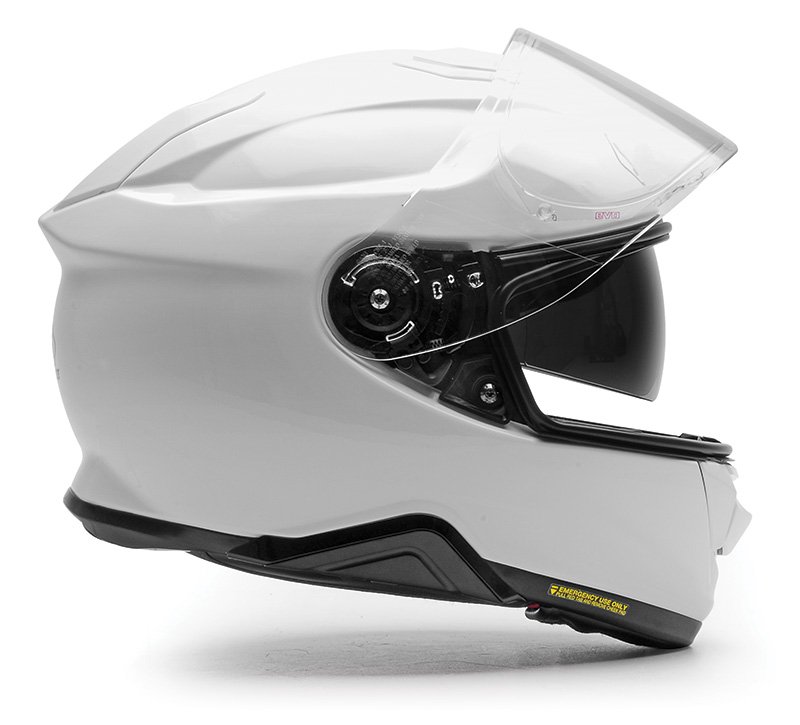
It is probably true to say that it is in the looks department that the GT Air 2 helmet is least changed. At first glance it seems very similar. But it is totally new shell that has been tweaked in every direction to make it fit or work just that little bit better.
The back of the helmet now looks very much like the rear of the Neotec 2 and, in truth, it would not be too unfair or inaccurate to suggest that the new GT Air 2 is pretty much a full-face version of the company’s latest flip-lid.
It is, in effect, a Neotec 2 for those who didn’t like flip-lids.
The shell employs Shoei’s fabled AIM construction that it uses in almost all of its high-end helmets. AIM stand for Advanced Integration Matrix, and basically it’s a multi-layering of strong glass and organic fibres.
The construction makes for a shell that is both light in weight and strong, but crucially it delivers a good degree of elasticity. This elasticity is important in an accident because it initially helps absorb an impact. But an AIM shell is still strong enough to withstand heavy landings without splitting.
Some helmets, including some very well known racing brands, have very strong but inelastic shells. These shells can resist multiple impacts in an accident and won’t crack. But they are poor at absorbing impacts, which is vitally important when there’s a requirement to slow down the acceleration of the brain from one side of the helmet to the other, when there’s a heavy landing.
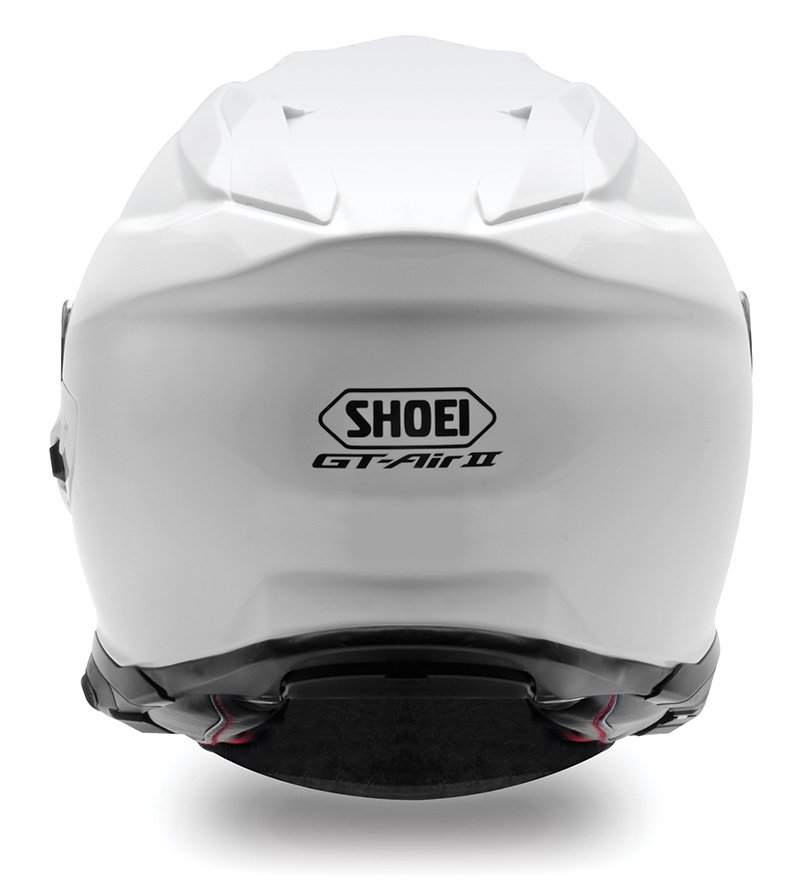
At the other end of the spectrum are helmets that have much softer shells. These shells, often polycarbonate shells, absorb impacts very well. These helmets often score very well in the SHARP tests, which measure energy absorption above all else. But the problem with these shells is that, in an impact, they can crack, so if you then have a second impact on the other side of the helmet, the shell can have totally lost its integrity.
The Shoei AIM shell is, in our view, the perfect compromise. It’s tough enough to withstand substantial impacts without cracking, yet it is still capable of absorbing large amounts of energy.
As motorcyclists, we are often influenced by inconsequential considerations such as colour and graphics, but if safety were the primary consideration, as it always should be, you’d probably only ever wear a Shoei.
Inside the shell, you obviously get a multi-layer eps. Now this has different levels of adsorption with the outer layers being firmer than the inner ones., but on the Shoei the densities also vary around the helmet, so the side areas are constructed differently from the frontal areas and so on.
Shoei is not the only company that works with variable eps structures, but Shoei is probably the most obsessive company in the business with more men in white coats testing the effects of differing eps densities than any other manufacturer in the business.
You also need to bear in mind that you don’t have to go far down the food chain before you get none, or at least very little, of this technology. More brands than you can imagine have their helmets made by third party factories in places like China or Vietnam. Our view is that, if a company makes its own helmets in its own factories, you can be reasonably confident that quality controls are going to be rigidly enforced.
But where a company merely put its badge on a helmet made in somebody else’s factory, alongside numerous other brands, you can be confident that safety is not going to be given such a high priority.
This is a long way round way of saying that with the GT Air 2, and indeed all Shoeis, safety really is the number one consideration. You simply cannot buy a better or safer helmet.
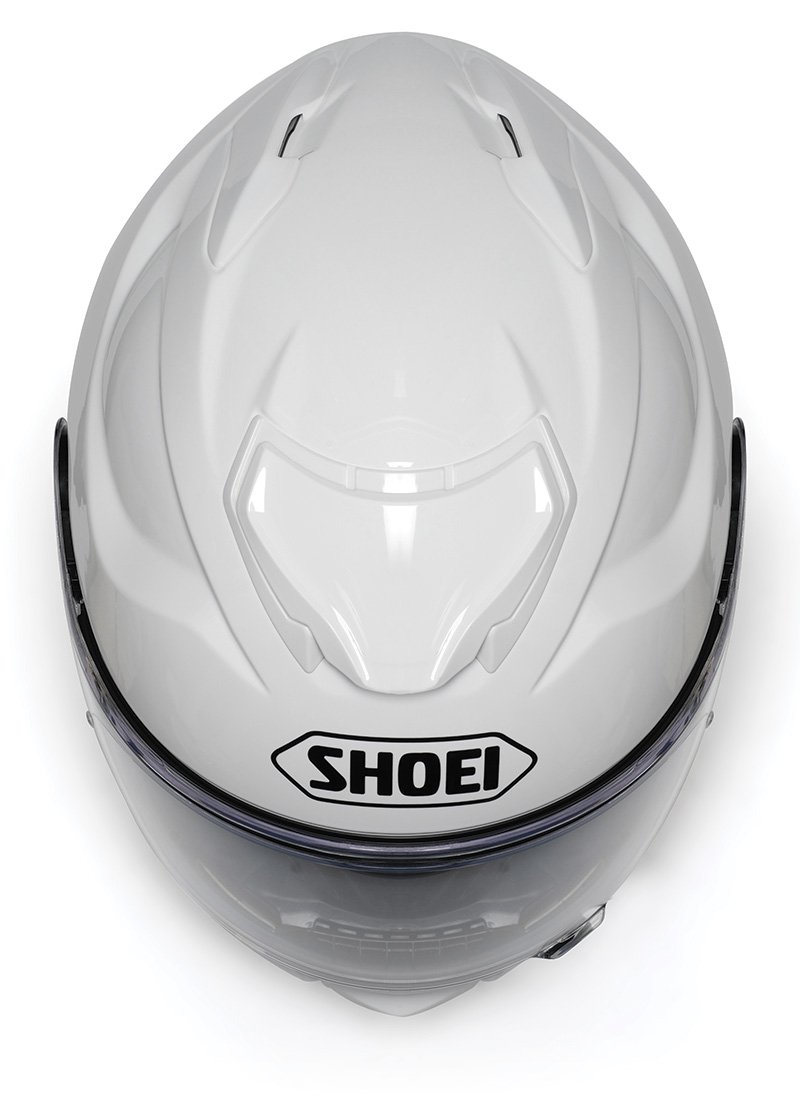
There are three areas for ventilation in the new GT Air 2.
There’s the Upper Air Intake on the brow of the helmet, a Lower Air Intake beneath the visor, on the chin, and a Top Air Outlet at the back.
On the new GT Air 2, the shutter on the Upper Air Intake has been re-positioned upwards to draw in more air. This air as it passes out through the vent and out of the vent’s outlet holes, helps remove the build-up of warm air that builds up around the visor, thus keeping the rider cooler, and reducing the potential for fogging.
The Top Air Outlet at the back of the helmet remains open all the time, allowing warm air inside the helmet, and around the head, to escape from outlet holes.
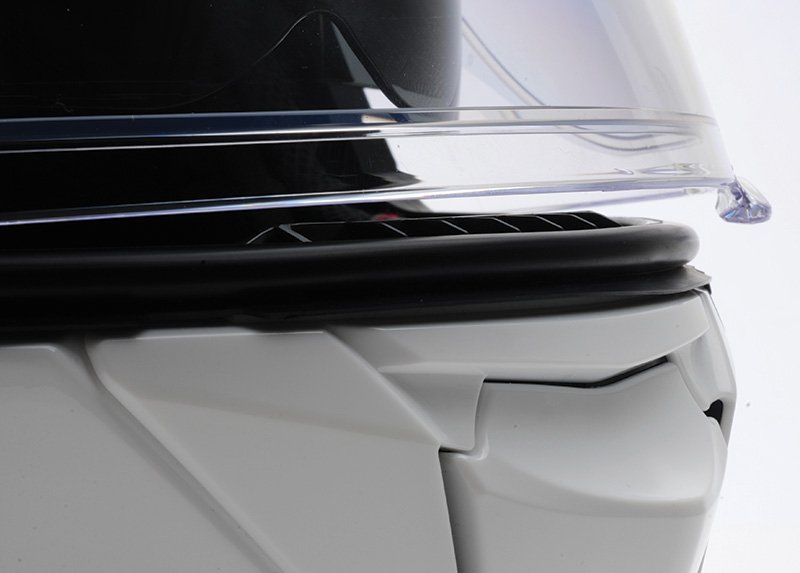
The Lower Air Intake opening has been enlarged on the GT Air 2 to allow greater air flow. This again pushes air through the helmet and out of the Upper Air Intake to reduce the build-up of heat, and lessen the propensity for condensation.
The venting on the new helmet, is, therefore, much improved. But on the GT Air 2 you also have the ability to crack the visor open a little so that, in high humidity, or in situations where the internal and external temperatures are exaggerated, you can mitigate the situation by increasing the flow of air into the helmet.
Of course, the helmet comes with an EVO Pinlock, in essence a top-of-the-range 120 Pinlock, which reduces as much as it can the possibility of fogging.
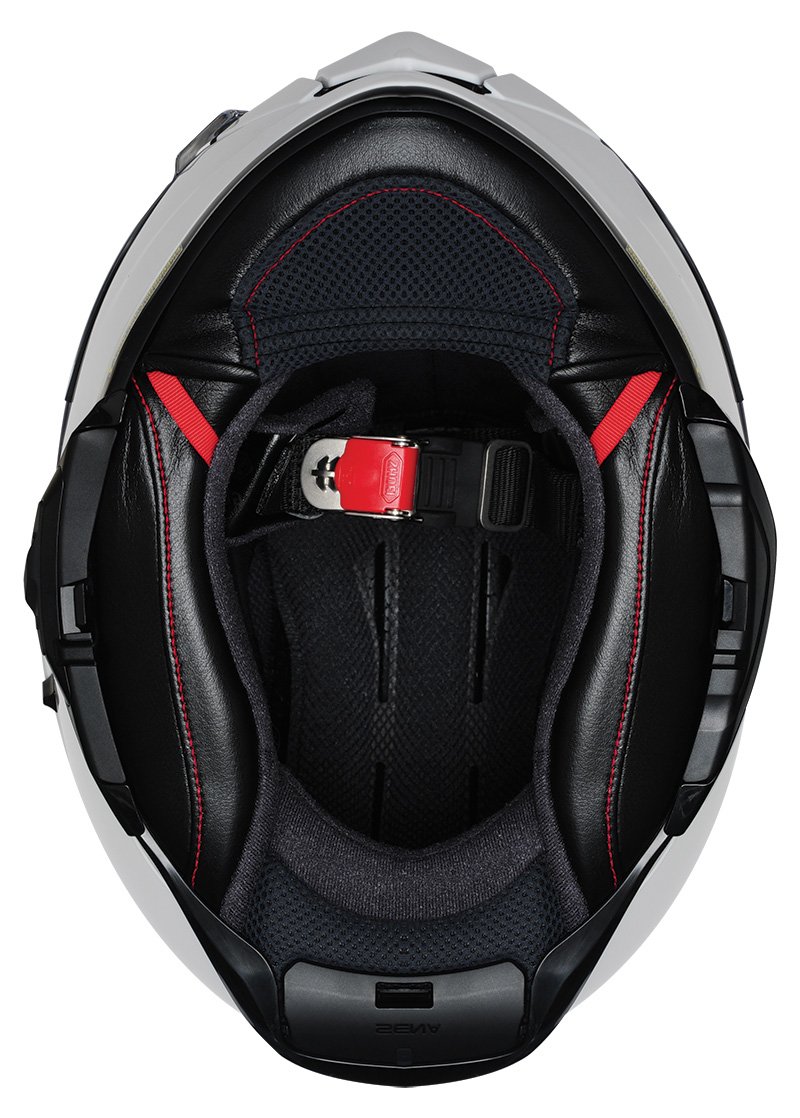
A helmet is a safety device, so the way it protects the wearer is all-important, but to ride safely, especially over a long period, a rider has to be comfortable. It is, in our view, the secret to the very best bike gear. If gear is comfortable to wear, and causes no destruction, all your energy and concentration can go into the riding of the bike.
The GT Air 2 comes in three shell sizes. The shell size, per se, does not make a helmet comfortable. But the more sizes a helmet comes in, the greater the ability to create helmets that have the correct balance of eps layers and comfort lining.
But, as with other helmets in the Shoei range, what makes the GT Air 2 so comfortable to wear is that each of the five sizes can accomodate three different headliners and three different thicknesses of cheek pads.
You’ve probably aware that cheek pads and linings can be removed from many helmets, but with most brands this facility exists only to allow the components to be washed.
With many helmet brands the different sizes are arrived at by the fitting of separately-sized cheek pads. But that’s not how Shoei does it. With a Shoei helmet, every size is fitted with a 35 mm cheek pad and a 9mm headliner. Every helmet can then take a thinner cheek pad or headliner. Or a thicker one.
What’s more, only Shoei, of all the manufacturers on the market, offers a free exchange of pads so that you can take a thinner headliner or a thicker cheek pad at no extra cost.
Not Arai, AGV, Shark, Bell or any other helmet maker lets you get a helmet fitted perfectly to your head, without having to buy the expensive, new interior parts. If you want a comfortable helmet, a Shoei is always going to be your best bet. And if you want a full-face touring or commuting helmet, none is going to fit as well as a GT Air 2.
The lining of the Shoei GT Air 2 is made from a highly-absorbent, quick-drying material that faces all those areas that come into contact with the cheeks and brow. A softer fabric is used in those parts of the helmet that come into contact with the face when you put on, and take off, the helmet.
One significant change from the old GT Air is that the micro-ratchet chinstrap has been lowered and moved forward in order to put less pressure on the throat.
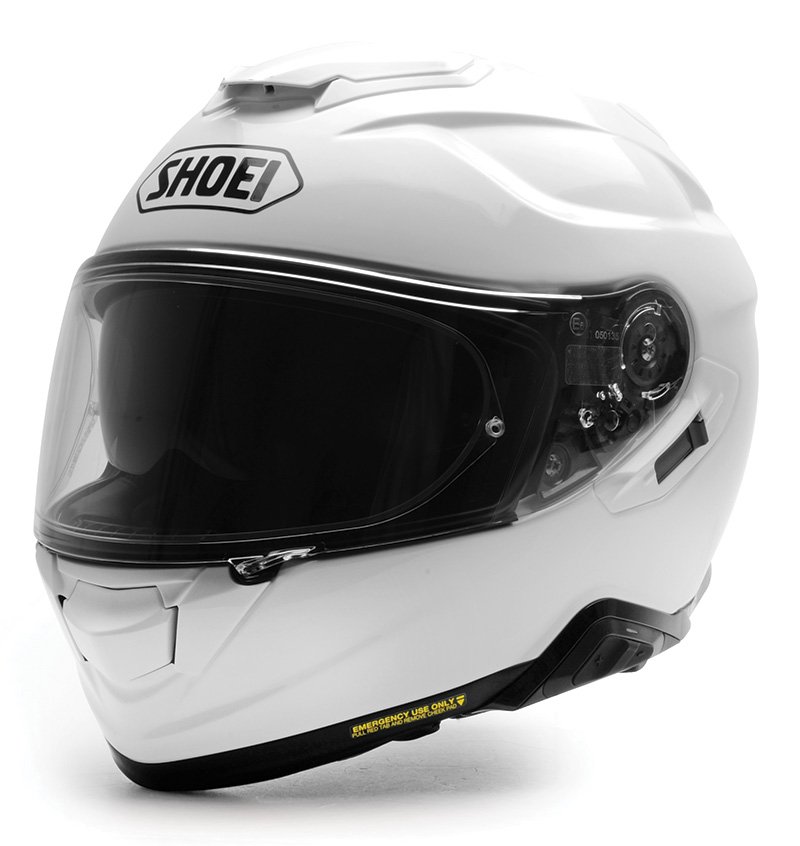
The Grade 1 optical-quality visor on the GT Air 2 has been designed to allow the helmet to be worn with the visor cracked open, to allow a greater flow of air. You might do this to cool down, but you might also want to ride with the visor slightly ajar when it’s cold or wet, to stop condensation on the inside of the visor.
Of course this will only ever be required in extreme conditions, because the GT Air 2 has generous venting and, of course, it comes with Pinlock’s very best anti-fog insert. But if the helmet still cannot cope, the ‘cracking’ of the visor is still an option.
Most helmets, historically, have used a double-lip seal to prevent the wind and the rain from passing through the edge of the visor. The new GT Air 2 uses the same P-shaped beading that was developed for the Neotec 2. It’s just one of the many features that makes the GT Air such a quiet helmet to ride in.
As you would expect of a touring/commuting helmet, the GT Air 2 has a drop-down sun visor. But the sun visor on the new GT Air 2 is 5mm deeper than it was on the helmets’ predecessor. It cuts down the amount of light that gets through, but it also increase the coverage of the face if you decide to ride with the external visor in the up position.
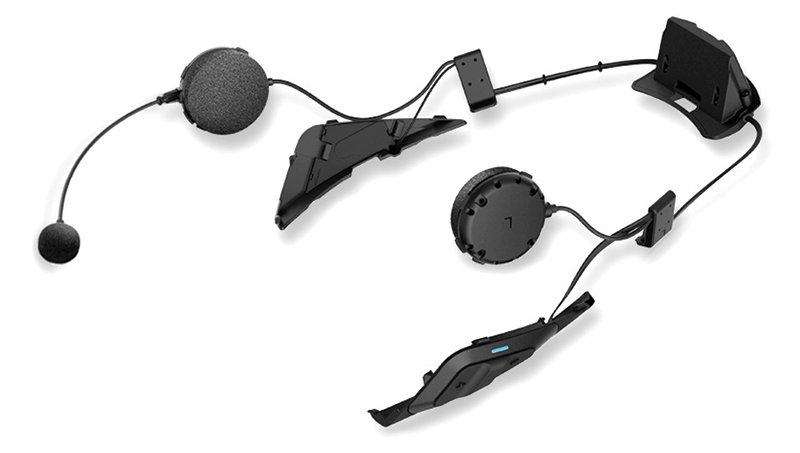
The other major step forward for the GT Air 2 over the current GT Air is in its comms. system.
The New GT Air 2 will now take a version of Sena’s top-of-the-range 20 model. The helmet is channelled ready to take the comms. system, so there’s no tricky, Heath Robinson-style improvisation required to fit it. It all slots and clicks into place.
And there’s no ugly box on the side to add noise. On the right hand side, to replace the slide-in plastic panel, goes the aerial. On the left hand side, you get the channel and volume controls.
Sena make the best comms. on the market, which is why, in the last 18 months, both Shoei and Schuberth has moved over from Cardo. But the Sena SRL2 comms. has been designed specifically to fit exclusively into the GT Air 2.
You can always stick an Interphone or some other unit onto the side of the Shoei, but it would be a shame. This system has been designed to integrate perfectly into the GT Air 2. It has all the functionality you could ask for; the best physical reach; and all in a package that is totally discrete and streamlined.
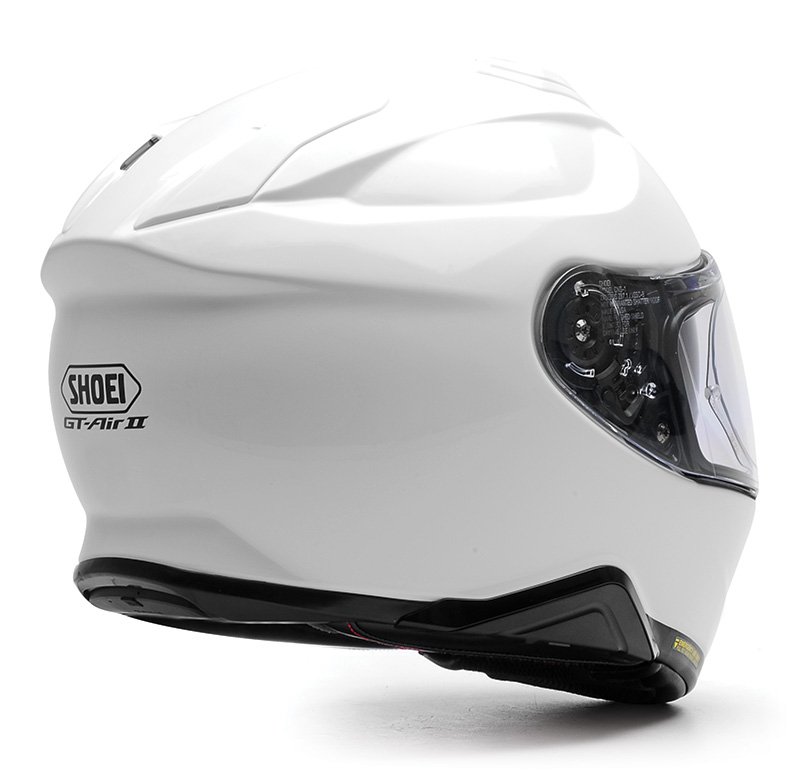
Its difficult for us to be totally objective about the GT Air 2.
Firstly, because we haven’t done many miles in one, and secondly because we have come to respect Shoei’s helmets above all others.
We have done about 100 miles in the GT Air 2 prototype, and it was everything we expected it to be. It was comfortable, quiet and did exactly what we expected of it. But we weren’t able to change the cheek pads because they’re not yet available. And we didn’t get to ride it in heavy rain. But we know Shoei, and they don’t get these things wrong. We know it’s not going to leak and we know that, with the option to change the internals, we can make the GT Air 2 as comfortable as a pair of slippers.
Last year, Shoei released the Neotec 2. We’ve had hugely positive feedback on it. Everybody loves it. We’ve had next to no issues. And I’m not sure we’ve failed to make it fit perfectly on more than a couple of people.
As the GT Air 2 is really just a full-face Neotec 2, we’re confident it’s going to be just as reliable and just as easy to live with.
Here at Motolegends we love flip-lids, and we don’t see why some people don’t like them. But we know that some people prefer a full-face. So, our view is that if you commute, or do a fair amount of touring, there’s probably not a better quality, more sophisticated and more comfortable full-face helmet on the market.
You’ll find racier. You’ll find sexier. You’ll find more exotic paint jobs. And if you’re the kind of rider who prefers to have a racer’s name and number on your helmet, then you’ll find lots of helmets that are going to suit you more than the GT Air 2.

Which brings us finally, to price.
This is not a cheap helmet; but it’s a Shoei so you wouldn’t expect it to be. But you could easily spend a lot more and, in all likelihood, you’d only get less.
In black or white, the GT Air 2 is £450. Fancier colours are £470. The graphic treatments are £550. Some of the ‘toy’ helmets out there with no venting, no sealing around the visor, no Pinlock, and no adjustment on fit cost more than this. Given this, we don’t find the price range of £450 to £550 to be unreasonable.
But what makes the GT Air 2 such good value is that you can swap the headliners and cheek pads at no cost.
Try and do this with any other helmet brand, and you’ll very quickly be out of pocket. Of course, not every Shoei dealer out there offers the ability to change the internal liners, because not everybody carries them. Obviously, at Motolegends we do, so if you want to make sure your GT Air 2 fits as it really should, it might be worth making your way to Guildford.
The new GT Air 2 is expected to arrive in the shops in March.
Click Shoei GT Air 2 helmet to shop the Shoei GT Air 2 helmet.
































































